Got another one of those: "gee, you seem to be spending your Peace Corps service at Ukranian bars" emails. It was actually a supportive email other than that, but I would like to make a correction: I actually don't spend spend a lot of my Peace Corps service at Ukranian bars. I spend it at Ukranian discos, and my time there is important for language acquisition, cultural integration, and oggling beautiful women. Most of these are in the Peace Corps Handbook as being essential to success at site, but I leave it up to you to figure out which ones.
It came right before an intended blog on work anyway, which I swear I try to keep balanced with "Daniel having fun" and "Ukranian Culture" blogs.
Anyway, the lead off in the work news is that we just had our last training at the wall. We went out with a bang: 16 participants were trained! It concluded eight weeks of me promoting the wall during the week (every week I visited an average of six classes at local schools and distributed about 100 flyers) and eight Saturday trainings. Final numbers: 82 people trained in eight weeks, 61 of whom were under 18. That's in addition to the 93 trained since the wall's opening in November (during which it wasn't promoted; we were waiting for warmer weather). Each of the 82 people trained in the past eight weeks also recieved a one-hour course in HIV/AIDS prevention.
The HIV/AIDS courses, I feel, are what really mark the success of the wall. Initially it was to provide a recreational option in a city where there are few save playing soccer on dirt fields. But because Polissya has been having problems (some motivational, some staffing) with keeping the wall open regular hours and because HIV/AIDS awareness is so low in Ukraine (a recent poll showed that only 14% of 16-25 year-olds could correctly name the ways HIV is transmitted) that pairing the draw of the wall with an HIV/AIDS awareness class really make the money invested (AKA your tax dollars) worth it.
Of course, I thought that would be our last training for a bit, but I got a call last night to go visit the village of Ivanivka this morning to do a presentation. Irina, one of my trainers is from there, and she wanted to bring students from her old school to the wall(I told my trainers that they could start promoting the wall and I would open it for any training they wanted to do). So I got up early and caught a marshrutka out there and we'll be having training this weekend. This is added two at least two planned by volunteers: Jon is bringing a group from the Rivniska oblast and another volunteer is bringing a group from the Kyivska oblast. Thinking we should expand that, I put out an all-call on the volunteer bulletin that we would schedule trainings for any volunteer bringing a group of students in over the summer, so maybe even more Ukranians will get to experience climbing and become more informed about HIV/AIDS!
On a side note, after today's trip I am starting to realize that Ivanivka might merit a documentary of sorts. I've mentioned Ivanivka before: it's the town with the mass graves from the Holocaust. But, as I learned today (as it was behind the school I gave the presentation at), it has an old collective farm from the Soviet era. It was creepy: high concrete walls, a guard tower and a sliding metal gate normally reserved for military bases surrounded the farm. The gate was ajar and inside were a dozen buildings: the remains of a huge concrete barn, paddocks where milking cows were kept, the collapsed wooden coops where chickens were kept. It wasn't so much as a farm (although fields still used by the village sat just behind the walls) as a food factory. I hadn't brought my camera with me (always a mistake in Ukraine), but Irina told me her father used to be a bookkeeper at the collective, so maybe I can have him come out with me and have him point things out on camera, describe a bit of what life was like there. Along with the graves, footage of village life (this is where people hand-plant and hoe produce and then bring it to market by horse-drawn cart) and interviews with village residents about life now (one house had a satelite dish attached to the roof), it might make for an interesting encapsulation of Ukranian life, then and now. Or maybe it'll get buried under every other idea that I have...
*Just got the money in my bank account for the bike project. I'll be giving it to Polissya tomorrow and we will get that project rolling (pun intended). The first tours should start in July.
*The Across Ukraine Run is now getting moved to September, for a variety of reasons, the most major of which is that we should be getting a grant to cover most of the costs, but won't get the money until August. Other than that, a lot is finally starting to coalece. More and more people keep coming on board and taking up the slack in different areas, so I finally feel like we're almost to the apex and soon it will have enough momentum to succeed no matter what! And believe it or not, despite how big it's getting, I might have problems taking the 18 days needed to manage the trip as official leave. It was a bit of hoop-jumping to get four days approved to go teach for American Councils in July, because Peace Corps Ukraine is changing its policy that any work not directly related to your site does not count as official travel. Run Across Ukraine is not directly related to my site, but my manager understands that we'd been working on it for months prior to the travel-policy change. The problem is that he's about to be out of the country for a month. We had a phone conversation about the best time to submit the request (i.e., after he gets back, but before the new Country Director is installed) to get it approved. The interim director also strongly supports the project, so hopefully this won't be an obstacle, but it is entirely possible that they'll say I can't take official travel to do it, and I'm almost out of vacation days.
*My climbing camp is giving me fits. Finding dates that work for everyone is problematic. My Healthy Lifestyles teachers can't do it in the first half of July and my climbing instructors can't do the last half. I think I'll have to just set them and those that can't do it can't do it and we'll find replacements as needed.
We're also running into a funding snag. Polissya should be donating most of the equipment for climbing and camping, and American Councils should be donating use of teaching materials, so we're going to be able to fund it dirt cheap (I don't want to run my camp on grants, as that cuts back on sustainability), but I wanted to raise some extra funds via a car wash to buy the kids tee-shirts, etc. This is the answer Irina got back from the City Council: "Minors are not allowed to work, the government is in a mess right now (the elected mayor had her election overturned by the court due to falsification and there will be a re-election in July), and no one does car washes in Ukraine. Forget about it." Bear in mind all we need from them is PERMISSION to have the car wash, not any kind of support. And the excuse that minors can't WASH A CAR TO RAISE MONEY is ridiculous. I told Irina to get me a meeting with the head of youth services on the council next week, so hopefully we'll get it sorted out. That's the fourth Ukranian to say that "no one does car washes in Ukraine" as if that's a reason not to TRY to do something. Ultimately, I'm not that worried about funds: with the in-kind contributions, the camp is designed to run as cheaply as possible (it will run 9 AM to 3 PM specifically so that we don't have to feed them) and I'm willing to fund the rest out-of-pocket, but I'd like to set it up so that it can continue itself without me. I'm already hopefull of that: Marina, Irina and Tanya are taking on a lot of management responsibilities of the camp, and I hope to leave it to them after I'm gone. They're making me really proud, actually!
*Just finished another cycle of courses at the insitute. I LOVE my job there (which is good, because it's my main job). I teach the same set of classes to a different group of teachers every month, which means that my lesson plans just keep getting refined instead of the stress of making new ones for every single class. Also, since the cycle only lasts a month, at the end of every month my teachers give me candy or (if I have a good rapport with the group, like this last one) little gifts. If I'm lucky, I get both, and yesterday I was lucky. Yesterday I got my candy and my gift (a little figurine of a cossack and his wife) and said good-bye to another great group of teachers. I estimate that 1/10 of the English-teaching teachers in the oblast have been my students, something proved when I travelled around the oblast doing observations this month: at every single school I visited, even including the school I saw today in Ivanivka, at least one of the teachers knew me. The new volunteers will begin to introduce me to one of the teachers they work with and either I or the teacher will stop them because we already know each other. "How?" the new volunteer will ask. "She used to be my student," I will say. It's fun.
But enough about work. I finished another 5.11a on top-rope on Sunday and I want to make an attempt on lead today. I'm meeting Marina in an hour to attack it. It's time to go climbing.
Tuesday, May 30, 2006
Monday, May 22, 2006
Ukraine: St. Sophia, A Heartbreaking Story, A White Whale
Tuesday was the day of Saint Sophia. Despite almost two years in Ukraine, I’m not clear on why she’s a saint or what she did, but the colossal blue cathedral in Kyiv that’s on the UNESCO treasures list was built to her, so obviously she’s pretty important to Ukrainians.
My friend Tanya is in a Christian band that was playing at a concert held on Saint Sophia’s day, so we went over to check it out. It was held in front of Zhytomyr’s Catholic Church. There’s only one Catholic Church in Zhytomyr because Catholicism doesn’t have nearly the hold hear that Orthodoxy does. In fact, plans to build another Catholic church in Kharkov were halted do to an outcry from the Orthodox churches that Catholicism was starting to take over. Yeah, there’s that kind of intolerance. With that kind of outrage over a Christian church, I asked my friend Lisa, who is from Kharkov, what the Ukrainians would do if someone tried to build a mosque there.
“Oh, they wouldn’t care,” she said. “Because it’s not a threat.”
The church was new by Ukrainian standards, only 300 years old, but pretty: a gothic facade in peach and white. An empty stage was set up in front of the church and we waited beside it until the Sophia Day service was over and the congregation piled out of the church to watch the performance.
The music was upbeat gospel, with touches of jazz and rock thrown in. During it, the coolest priest I’ve ever seen, a perpetually-smiling man of about 30, was leading a sort of conga line through the crowd. Instead of hands on hips they had just all held hands to form one big chain, and moved past us in a sort of half-run, half skip.
Then the whole crowd began to do circle dances. They did one traditional Ukrainian one: where everyone holds hands, does this sort of cross-back, cross-forwards step to run in a circle before the whole circle runs towards each other to meet in the center, then runs backwards again to spread the circle back out. Then an MC on stage began coaching the people through many more circle dances that (my friend later told me) they said they had learned from a Polish Catholic congregation. One was vaguely Indian with its twisting hands and hop-step, one was vaguely Celtic/Irish in its moves and so on and so forth, but all were pretty cool. I filmed for a bit but then just got in one of the circles, doing the dances with them. Towards the end they were fast and almost out of control, with people forming smaller circles within the bigger ones and having a hell of a lot of fun.
I still don’t know what Saint Sophia did, but apparently she knew how to party.
***
I was leaving the library on Thursday when I heard English, and I heard it in a sing-song, lilting accent. I was leaving the library with Kirstin, another volunteer and we both stopped, looked at each other, and Kirstin said what I was thinking: “she’s not from Ukraine.”
The English was being spoken by a woman in her early thirties pushing a stroller, and her name was Anna, and, it turned out, she really was Ukrainian. Her child, Marina, though, was American and her husband, Marina’s father, was from the Democratic Republic of Congo.
When we got it sorted out, her rather heartbreaking story was this: Anna grew up in Ukraine and learned English here. While in Poland visiting a friend, she met her future husband. Although her husband only spoke Swahili and French and Anna spoke neither, they fell in love and her husband began to learn English for her. It was amongst her husband’s African relatives that she picked up the sing-song English accent.
Her husband moved to America, illegally, to find work and Anna followed him there on a tourist visa, even though she had only one year left in her University schooling. She became pregnant and Marina was born in America. Marina currently has both passports.
Anna came back to Ukraine to finish school, but afterwards when she tried to return to America with Marina, she was not allowed to. The American embassy was worried (correctly) that she would skip on her visa and stay in America with her child. So Anna hasn’t seen her husband and Marina hasn’t seen her father since. Her husband still supports her and the baby, sending money from America, but he can’t leave America because he would not be able to return, and even if he came to Ukraine, as Anna pointed out “who would give a black man a job in Ukraine?”
So to support his family he stays there work and she lives here and waits.
Marina is a beautiful little girl, almost three years-old with mocha skin and extremely curly hair. The hair gives Anna fits, she was saying, because she doesn’t know how to control it. She’s waiting for her mother-in-law, who lives in Congo, to bring some hair product when they both meet in Turkey this summer, one of the few countries where neither woman needs a visa. The mother-in-law, who could get a tourist visa to America, wants to take Marina with her to see her father. Anna doesn’t want her to, because she’s worried her Mother-in-law and her daughter won’t come back.
Marina loves attention and kept making faces at Kirstin and I to get it. When her mother finally let her out of her stroller, she was darting around on the sidewalk, running farther away than most kids are willing to be from their mothers and often causing Anna to chase off because she was reaching into a trash can or about to get into a fountain.
I don’t know why, but watching Anna scold Marina in Russian, my saddest thought was that if this family could be together, Marina would grow up speaking five languages: Russian, Ukrainian, English, Swahili and French.
Anna, tired of chasing her, finally strapped Marina back into the stroller, where she once again began making faces at Kirsten and I, smiling what few teeth she had at us. Anna took both our mobile numbers, saying she was glad to have people to practice English with, and then, pushing the stroller ahead of her, said good-bye and walked away.
***
I climbed my first 5.11b on Sunday. It was only Jon and I, which meant we could just seriously work on skills. We skipped out on going out Saturday night and got up at 5:30 AM, when the only people up were some fishermen on the river and us.
It was on top rope and yet still a sloppy climb, resting after almost every move. One move, the hardest, required a two fingered left-hand pull-up. I’m not kidding. This is why I’m still not a 5.11 climber. Instead of pulling the move clean, I worked my body up so that the rope would take some of my weight and I could half-swing up to the next hold (which, as it turns out, is only the tips of all four fingers, but on my right hand).
We were able to set a top rope because Jon was able to lean over the top of the cliff, me sitting on his legs, and put the rope through the anchor. After I finished it on top rope I tried to lead climb it (a climb doesn’t count unless it’s on lead), but I hit that two-finger pull-up move, fell, gashed open my shin and called it a day.
So I’m not a 5.11 climber yet, but I can feel it coming. That route (which is named after a three-headed dragon in a Ukrainian legend) is my new white whale.
My friend Tanya is in a Christian band that was playing at a concert held on Saint Sophia’s day, so we went over to check it out. It was held in front of Zhytomyr’s Catholic Church. There’s only one Catholic Church in Zhytomyr because Catholicism doesn’t have nearly the hold hear that Orthodoxy does. In fact, plans to build another Catholic church in Kharkov were halted do to an outcry from the Orthodox churches that Catholicism was starting to take over. Yeah, there’s that kind of intolerance. With that kind of outrage over a Christian church, I asked my friend Lisa, who is from Kharkov, what the Ukrainians would do if someone tried to build a mosque there.
“Oh, they wouldn’t care,” she said. “Because it’s not a threat.”
The church was new by Ukrainian standards, only 300 years old, but pretty: a gothic facade in peach and white. An empty stage was set up in front of the church and we waited beside it until the Sophia Day service was over and the congregation piled out of the church to watch the performance.
The music was upbeat gospel, with touches of jazz and rock thrown in. During it, the coolest priest I’ve ever seen, a perpetually-smiling man of about 30, was leading a sort of conga line through the crowd. Instead of hands on hips they had just all held hands to form one big chain, and moved past us in a sort of half-run, half skip.
Then the whole crowd began to do circle dances. They did one traditional Ukrainian one: where everyone holds hands, does this sort of cross-back, cross-forwards step to run in a circle before the whole circle runs towards each other to meet in the center, then runs backwards again to spread the circle back out. Then an MC on stage began coaching the people through many more circle dances that (my friend later told me) they said they had learned from a Polish Catholic congregation. One was vaguely Indian with its twisting hands and hop-step, one was vaguely Celtic/Irish in its moves and so on and so forth, but all were pretty cool. I filmed for a bit but then just got in one of the circles, doing the dances with them. Towards the end they were fast and almost out of control, with people forming smaller circles within the bigger ones and having a hell of a lot of fun.
I still don’t know what Saint Sophia did, but apparently she knew how to party.
***
I was leaving the library on Thursday when I heard English, and I heard it in a sing-song, lilting accent. I was leaving the library with Kirstin, another volunteer and we both stopped, looked at each other, and Kirstin said what I was thinking: “she’s not from Ukraine.”
The English was being spoken by a woman in her early thirties pushing a stroller, and her name was Anna, and, it turned out, she really was Ukrainian. Her child, Marina, though, was American and her husband, Marina’s father, was from the Democratic Republic of Congo.
When we got it sorted out, her rather heartbreaking story was this: Anna grew up in Ukraine and learned English here. While in Poland visiting a friend, she met her future husband. Although her husband only spoke Swahili and French and Anna spoke neither, they fell in love and her husband began to learn English for her. It was amongst her husband’s African relatives that she picked up the sing-song English accent.
Her husband moved to America, illegally, to find work and Anna followed him there on a tourist visa, even though she had only one year left in her University schooling. She became pregnant and Marina was born in America. Marina currently has both passports.
Anna came back to Ukraine to finish school, but afterwards when she tried to return to America with Marina, she was not allowed to. The American embassy was worried (correctly) that she would skip on her visa and stay in America with her child. So Anna hasn’t seen her husband and Marina hasn’t seen her father since. Her husband still supports her and the baby, sending money from America, but he can’t leave America because he would not be able to return, and even if he came to Ukraine, as Anna pointed out “who would give a black man a job in Ukraine?”
So to support his family he stays there work and she lives here and waits.
Marina is a beautiful little girl, almost three years-old with mocha skin and extremely curly hair. The hair gives Anna fits, she was saying, because she doesn’t know how to control it. She’s waiting for her mother-in-law, who lives in Congo, to bring some hair product when they both meet in Turkey this summer, one of the few countries where neither woman needs a visa. The mother-in-law, who could get a tourist visa to America, wants to take Marina with her to see her father. Anna doesn’t want her to, because she’s worried her Mother-in-law and her daughter won’t come back.
Marina loves attention and kept making faces at Kirstin and I to get it. When her mother finally let her out of her stroller, she was darting around on the sidewalk, running farther away than most kids are willing to be from their mothers and often causing Anna to chase off because she was reaching into a trash can or about to get into a fountain.
I don’t know why, but watching Anna scold Marina in Russian, my saddest thought was that if this family could be together, Marina would grow up speaking five languages: Russian, Ukrainian, English, Swahili and French.
Anna, tired of chasing her, finally strapped Marina back into the stroller, where she once again began making faces at Kirsten and I, smiling what few teeth she had at us. Anna took both our mobile numbers, saying she was glad to have people to practice English with, and then, pushing the stroller ahead of her, said good-bye and walked away.
***
I climbed my first 5.11b on Sunday. It was only Jon and I, which meant we could just seriously work on skills. We skipped out on going out Saturday night and got up at 5:30 AM, when the only people up were some fishermen on the river and us.
It was on top rope and yet still a sloppy climb, resting after almost every move. One move, the hardest, required a two fingered left-hand pull-up. I’m not kidding. This is why I’m still not a 5.11 climber. Instead of pulling the move clean, I worked my body up so that the rope would take some of my weight and I could half-swing up to the next hold (which, as it turns out, is only the tips of all four fingers, but on my right hand).
We were able to set a top rope because Jon was able to lean over the top of the cliff, me sitting on his legs, and put the rope through the anchor. After I finished it on top rope I tried to lead climb it (a climb doesn’t count unless it’s on lead), but I hit that two-finger pull-up move, fell, gashed open my shin and called it a day.
So I’m not a 5.11 climber yet, but I can feel it coming. That route (which is named after a three-headed dragon in a Ukrainian legend) is my new white whale.
Ukraine: Ded Kolia and Gouliating
So I finally got some time at the computer and here are the first two of five interesting stories from the past week:
-My friend Olya, who lives in Kyiv but is from Zhytomyr, was in town for the weekend. We met to hang out, and I was told that we had to go see her grandmother, because Olya had promised to see her, and this killed two birds with one stone. It was already 9:30 PM, but with long summer days to match the short winter nights, meant there was still some light out. Still, it wasn’t until I got on the marshrutka with Olya that I was told her grandmother didn’t live in the city, but in a village outside of it.
It was full dark by the time we got there, which is how I found myself feeling my way across a creaking bridge of cobbled together metal plates to cross the Teatriv and get to this tiny village. Her grandmother, who lived in a two-room tiny house that was more than a century old, was really cool: youthful for her age and full of energy. While Olya’s eight year-old cousin attacked her in a hug and began jabbering about the birthday party she had had the previous weekend, the grandmother stuffed me full of dyruni (fried potato pancakes) topped with sour cream and told me in breakneck Russian about this guy she knew named Ded Kolia.
“Ded” means grandfather, but Kolia wasn’t so named because of his age but because of his actions during World War II. I don’t know why she thought a story from the war would be one to tell me unbidden. Maybe it’s because World War II was one of those few times that Americans and Soviets were on the same side. In any case, she was right, because I like to hear any kind of interesting story and those from World War II almost always seem to be interesting.
Only one generation out of Germany and able to speak German, Ded Kolia was named the administrator of her village by the Nazis after their war machine rolled through. Rather than being loyal to his German roots though, Ded Kolia used this new clout to forge papers for people who were being sent to the death camps. Instead of going to the camps, these Ukrainians lives were saved by being sent to Korestichiv, a town just north of Zhytomyr where, her grandmother told me, they would then join the large partisan resistance that was brewing there.
Then the story gets sadly ironic. Although he retreated with the Germans, Ded Kolia and his two sons were allowed to come back to Ukraine after the war ended. Despite saving so many people during the war, Kolia, possibly do to voicing anti-Soviet opinions, was sent to a gulag in Siberia, where he died.
Ded Kolia’s house was pointed out to me in the dark, on the way back to the bus stop to get me back to Zhytomyr. Olya and her grandmother tried to get me to stay the night, but I had to teach in the morning (yes, on a Saturday morning!). Olya wanted to walk me back to the bus stop (and I probably would have gotten lost if she hadn’t), but her grandmother didn’t want her returning alone, so all three girls: Olya, her grandmother and the young cousin, walked me to the stop.
Because it was so dark, Olya took one of my hands and her grandmother took my other and Olya’ cousin held her grandmother’s hand. So in this way these three Ukrainian girls walked the poor, lost American down the dirt road to the bus stop. It was a sweet moment.
Her grandmother invited me back to see the village in the daytime, because she says it’s beautiful and she wants to show me the apple orchids. I promised to return.
***
The next evening I was again walked by girls, this time Marina and Anya. It was after a long day of climbing with my class of boys, browbeating them up a route none of them thought they could do but two of them managed to complete. Anya called and asked if I wanted to get ice cream with her and Marina. This is what Ukrainians do.
When it’s warm, the most popular thing to do in Ukraine is to buy alcohol, ice cream or both and walk. The Russian and Ukrainian languages even have a verb for this: “Gouliat” and “Houliate”, respectively. There are other verbs for walking, but this verb particularly means leisurely strolling around the town, almost always with a beer in one hand and ice cream in the other, talking with your friends.
I’m an American. I’m not used to all this walking. Still, the weather was gorgeous, the chestnut trees were blooming and we gouliat-ed down Old Boulevard, the park and fountain lined avenue that stretches from a statue of Pushkin to a massive (but condemned) bridge that crosses the Teatriv River. Gouliat-ing on Old Boulevard is the equivalent of going to a club in America. Everyone is decked to the nines, girls baring stomachs, cleavage and thighs and guys in shined shoes and button down shirts (the two buttons generally undone and exposing gold chains), almost everyone sipping on beers and eyeing each other from their same-sex clusters. Both the girls had dressed up, hair done and wearing makeup (which I’m not used to seeing them in) and I stood out considerably because I was still in my climbing clothes, hair under a bandanna.
There actually was a club near Old Boulevard, in an old Soviet concrete amphitheatre, its walls topped with barbed wire. Inside, Russian pop boomed from speakers, DJed by a guy sitting in front of a computer under a large Coke-a-Cola umbrella. The price for this open-air impromptu club was 4 hrivna (80 cents for those playing the home game), a fifth less than any other club and for obvious reasons: they didn’t serve alcohol and they closed at 11 PM (when, invariably, everyone would be going to places that DID serve alcohol). For that price and with pumping music, I was down for a little daytime dancing. The weather was warm, the sun was setting and it seemed perfect, but the girls were too embarrassed to dance any place that didn’t have bad lighting.
So then I suggested we just sit in the grass and listen to the music. We don’t have any alcohol, they said. If you’re going to sit on the grass, they said, you have to eat and drink vodka or beer.
This is a rule?
No, it’s a tradition.
So we can’t just sit and listen to the music?
No.
I didn’t understand why they didn’t want to sit, relax, enjoy the sunset and listen to the music. They didn’t understand why I didn’t want to walk.
Because this is what Ukrainians do. They gouliat.
-My friend Olya, who lives in Kyiv but is from Zhytomyr, was in town for the weekend. We met to hang out, and I was told that we had to go see her grandmother, because Olya had promised to see her, and this killed two birds with one stone. It was already 9:30 PM, but with long summer days to match the short winter nights, meant there was still some light out. Still, it wasn’t until I got on the marshrutka with Olya that I was told her grandmother didn’t live in the city, but in a village outside of it.
It was full dark by the time we got there, which is how I found myself feeling my way across a creaking bridge of cobbled together metal plates to cross the Teatriv and get to this tiny village. Her grandmother, who lived in a two-room tiny house that was more than a century old, was really cool: youthful for her age and full of energy. While Olya’s eight year-old cousin attacked her in a hug and began jabbering about the birthday party she had had the previous weekend, the grandmother stuffed me full of dyruni (fried potato pancakes) topped with sour cream and told me in breakneck Russian about this guy she knew named Ded Kolia.
“Ded” means grandfather, but Kolia wasn’t so named because of his age but because of his actions during World War II. I don’t know why she thought a story from the war would be one to tell me unbidden. Maybe it’s because World War II was one of those few times that Americans and Soviets were on the same side. In any case, she was right, because I like to hear any kind of interesting story and those from World War II almost always seem to be interesting.
Only one generation out of Germany and able to speak German, Ded Kolia was named the administrator of her village by the Nazis after their war machine rolled through. Rather than being loyal to his German roots though, Ded Kolia used this new clout to forge papers for people who were being sent to the death camps. Instead of going to the camps, these Ukrainians lives were saved by being sent to Korestichiv, a town just north of Zhytomyr where, her grandmother told me, they would then join the large partisan resistance that was brewing there.
Then the story gets sadly ironic. Although he retreated with the Germans, Ded Kolia and his two sons were allowed to come back to Ukraine after the war ended. Despite saving so many people during the war, Kolia, possibly do to voicing anti-Soviet opinions, was sent to a gulag in Siberia, where he died.
Ded Kolia’s house was pointed out to me in the dark, on the way back to the bus stop to get me back to Zhytomyr. Olya and her grandmother tried to get me to stay the night, but I had to teach in the morning (yes, on a Saturday morning!). Olya wanted to walk me back to the bus stop (and I probably would have gotten lost if she hadn’t), but her grandmother didn’t want her returning alone, so all three girls: Olya, her grandmother and the young cousin, walked me to the stop.
Because it was so dark, Olya took one of my hands and her grandmother took my other and Olya’ cousin held her grandmother’s hand. So in this way these three Ukrainian girls walked the poor, lost American down the dirt road to the bus stop. It was a sweet moment.
Her grandmother invited me back to see the village in the daytime, because she says it’s beautiful and she wants to show me the apple orchids. I promised to return.
***
The next evening I was again walked by girls, this time Marina and Anya. It was after a long day of climbing with my class of boys, browbeating them up a route none of them thought they could do but two of them managed to complete. Anya called and asked if I wanted to get ice cream with her and Marina. This is what Ukrainians do.
When it’s warm, the most popular thing to do in Ukraine is to buy alcohol, ice cream or both and walk. The Russian and Ukrainian languages even have a verb for this: “Gouliat” and “Houliate”, respectively. There are other verbs for walking, but this verb particularly means leisurely strolling around the town, almost always with a beer in one hand and ice cream in the other, talking with your friends.
I’m an American. I’m not used to all this walking. Still, the weather was gorgeous, the chestnut trees were blooming and we gouliat-ed down Old Boulevard, the park and fountain lined avenue that stretches from a statue of Pushkin to a massive (but condemned) bridge that crosses the Teatriv River. Gouliat-ing on Old Boulevard is the equivalent of going to a club in America. Everyone is decked to the nines, girls baring stomachs, cleavage and thighs and guys in shined shoes and button down shirts (the two buttons generally undone and exposing gold chains), almost everyone sipping on beers and eyeing each other from their same-sex clusters. Both the girls had dressed up, hair done and wearing makeup (which I’m not used to seeing them in) and I stood out considerably because I was still in my climbing clothes, hair under a bandanna.
There actually was a club near Old Boulevard, in an old Soviet concrete amphitheatre, its walls topped with barbed wire. Inside, Russian pop boomed from speakers, DJed by a guy sitting in front of a computer under a large Coke-a-Cola umbrella. The price for this open-air impromptu club was 4 hrivna (80 cents for those playing the home game), a fifth less than any other club and for obvious reasons: they didn’t serve alcohol and they closed at 11 PM (when, invariably, everyone would be going to places that DID serve alcohol). For that price and with pumping music, I was down for a little daytime dancing. The weather was warm, the sun was setting and it seemed perfect, but the girls were too embarrassed to dance any place that didn’t have bad lighting.
So then I suggested we just sit in the grass and listen to the music. We don’t have any alcohol, they said. If you’re going to sit on the grass, they said, you have to eat and drink vodka or beer.
This is a rule?
No, it’s a tradition.
So we can’t just sit and listen to the music?
No.
I didn’t understand why they didn’t want to sit, relax, enjoy the sunset and listen to the music. They didn’t understand why I didn’t want to walk.
Because this is what Ukrainians do. They gouliat.
Monday, May 15, 2006
Ukraine: My Day
Actually, the last three days have been very cool and I've got some feel-good Ukraine culture stories to put up, but no internet time (and I'm hungry).
So here was today: As a teacher trainer, I "manage" the ten Zhytomyrska Oblast volunteers in Practical Project and that includes observing their teaching once a semester. When I envision a manager, I envision this guy in a suit and tie, suitcase on his lap. And then I envision him in Ukraine, cramped on an archaic bus lurching in the rain down a road of broken asphalt, dodging around horse-drawn carts to get to a small village on the outer edge of the oblast to watch one 45 minute class.
It's not that bad: I planned lessons and studied Russian on the way there and back, but all told I was gone from Zhytomyr for seven hours and only saw my volunteer for a total of 75 minutes. The rest was on buses, waiting on buses, finding her school in the rain and standing in a hallway for 45 minutes waiting to speak with her after her lesson.
Yeah. That was my day.
So here was today: As a teacher trainer, I "manage" the ten Zhytomyrska Oblast volunteers in Practical Project and that includes observing their teaching once a semester. When I envision a manager, I envision this guy in a suit and tie, suitcase on his lap. And then I envision him in Ukraine, cramped on an archaic bus lurching in the rain down a road of broken asphalt, dodging around horse-drawn carts to get to a small village on the outer edge of the oblast to watch one 45 minute class.
It's not that bad: I planned lessons and studied Russian on the way there and back, but all told I was gone from Zhytomyr for seven hours and only saw my volunteer for a total of 75 minutes. The rest was on buses, waiting on buses, finding her school in the rain and standing in a hallway for 45 minutes waiting to speak with her after her lesson.
Yeah. That was my day.
Friday, May 12, 2006
Ukraine: The Past Two Weekends, Pt II (Pics)
Before going back to Kharkiv, Lisa braided my hair. It was nice to have it out of the way, but I ended up taking it out just a few days later for a formal meeting with the director of the orphanage that will be working with us on the bike project. Since the orphanage is on the outskirts of the city (completely isolated from the rest of Zhytomyr), we had to work out the logistics of getting them to the Polissya clubhouse and also found out what kind of paperwork would be needed to take “formal responsibility” of the orphans. I was hoping at least one worker from the orphanage could come on the trips with us simply for liability and discipline issues, but that may not happen. I'm slightly worried about having “formal responsibility” for wards of the state, considering I don’t let a single kid climb with us without their parents signing a waiver, but if it’s what we have to do, it’s what we have to do.
I have decided that braids are the way to go during the summer, though.
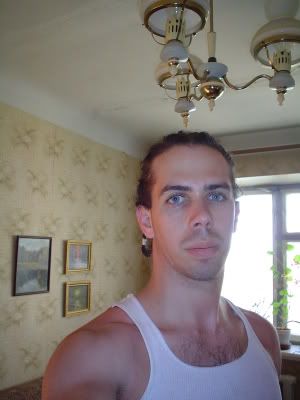
My hair in braids from the front. This is my "white trash" photo
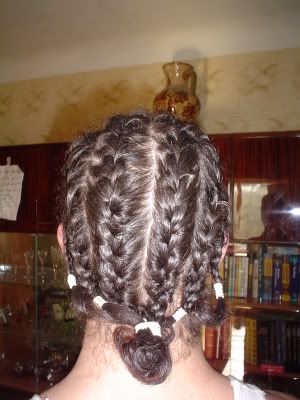
The braids from the back
Another weekend, another wall training, but this time it included Dasha and Nika, two friends of mine from Kyiv:

Nika's butt and Igor's everything at the wall
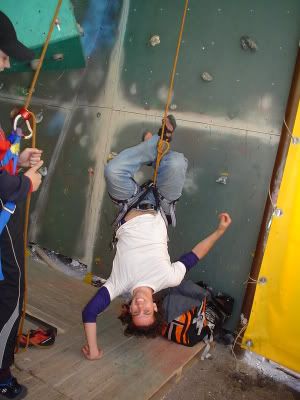
Yes, I am that strong. No, really. Seriously. Date me?
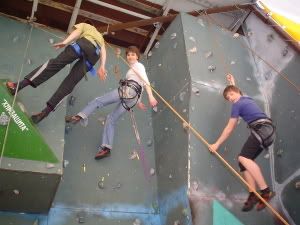
Igor, Dasha, Volva on the wall
Completely worn out from their first time climbing, they went to the club with me that night despite their exhaustion. We were supposed to meet up with other friends at the club, but a phone call later revealed they were too drunk from the pre-partying to even get out of their apartment. This left just the three of us and Dasha and Nika sharing me on the dance floor. Tough life. Actually, Nika is married and Dasha has been with her boyfriend for a year, but I think that made them more comfortable dancing with me rather than less, and post-alcohol we were getting pretty raunchy.
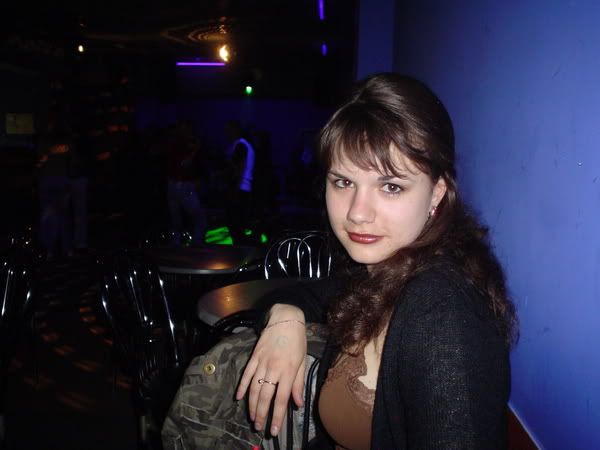
Dasha at the club
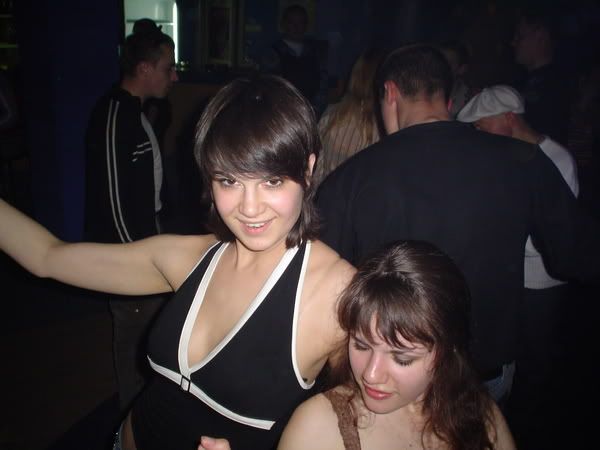
Dasha and Nika on the dance floor
Because they were tired and because I wasn’t leaving the dance floor, they were literally taking turns at the end of each song, one getting up to dance with me while the other sat back down at our table. The punchline of this story is that while Nika was dancing with me that Dasha, sitting with her back to a table but still able to overhear them, heard a girl remark about me: “well, he must have a lot of money if he can afford two prostitutes.”
I’d worry about giving Americans a bad name except, like I’ve said before on this blog, no one thinks I’m an American. They know I’m a foreigner, but when they ask where I’m from and I ask them to guess, they generally say France or Spain or, occasionally, Poland. This is such the general assumption that, while riding on a bus and talking to Dasha, a Ukrainian came up to me and started speaking to me in French. I told him in Russian that I don’t speak French and he kept on going anyway, finally ending with what sounded like a question, so I just said “Da.” He got off at that stop and Dasha asked: “what did he ask you?” “I have no idea,” I responded.
The next day rained out our hopes of climbing on the cliff, so we went back to the wall for a little bit before the girls said they were too tired to climb any more. So I took them to Zhytomyr’s space museum. I’d actually never been there, even though it’s Zhytomyr’s main bragging point. Sergei Karolov, who designed Mir, the first satellite in space, and Soyuz, the ship that took Gagarin, the first man in space, into space, was born in Zhytomyr. Hence, we have a cool museum with the original Soyuz ship, the return capsules, cosmonaut suits and a whole lot more. Possibly the coolest thing (and the most random) were a dozen chairs suspended from the ceiling that had headphones playing new age music. So I actually spent a good ten minutes resting my sore body on one of those, blissed out, wondering how to get one home to my apartment for use as a reading chair. Oh, and the entrance fee of this museum? One hrivna. Or, in American money, slightly less than 20 cents.
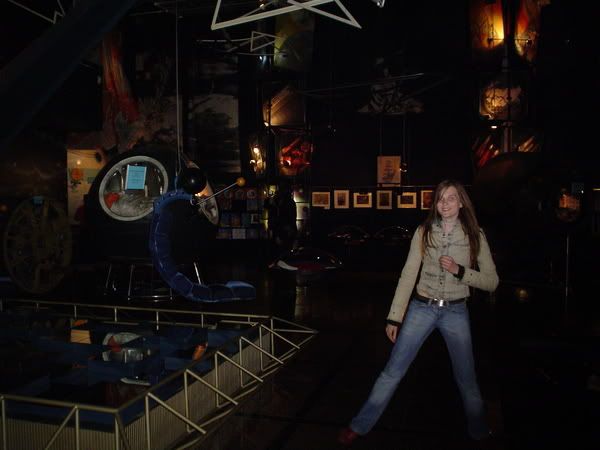
Anya in the space museum
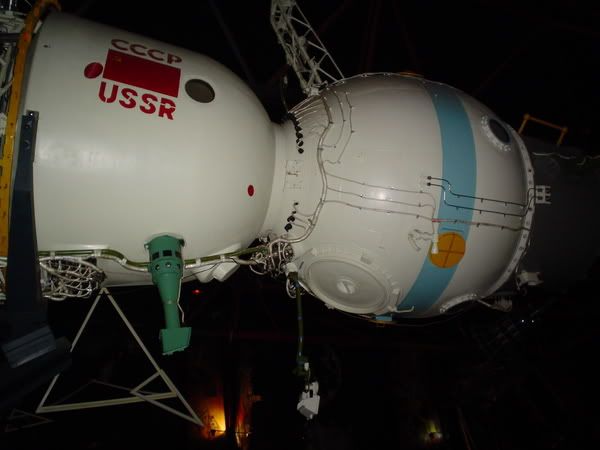
The actual Soyuz spaceship. It was smaller than I had imagined.
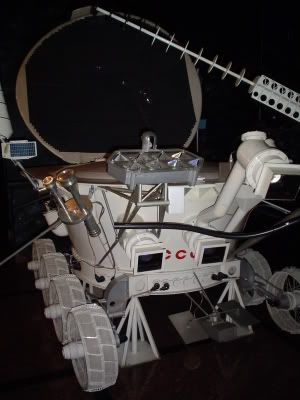
A crawler used to get samples from the moon.
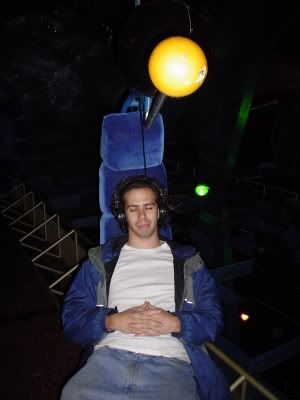
Blissed out in a space chair
I have decided that braids are the way to go during the summer, though.

My hair in braids from the front. This is my "white trash" photo

The braids from the back
Another weekend, another wall training, but this time it included Dasha and Nika, two friends of mine from Kyiv:

Nika's butt and Igor's everything at the wall

Yes, I am that strong. No, really. Seriously. Date me?

Igor, Dasha, Volva on the wall
Completely worn out from their first time climbing, they went to the club with me that night despite their exhaustion. We were supposed to meet up with other friends at the club, but a phone call later revealed they were too drunk from the pre-partying to even get out of their apartment. This left just the three of us and Dasha and Nika sharing me on the dance floor. Tough life. Actually, Nika is married and Dasha has been with her boyfriend for a year, but I think that made them more comfortable dancing with me rather than less, and post-alcohol we were getting pretty raunchy.

Dasha at the club

Dasha and Nika on the dance floor
Because they were tired and because I wasn’t leaving the dance floor, they were literally taking turns at the end of each song, one getting up to dance with me while the other sat back down at our table. The punchline of this story is that while Nika was dancing with me that Dasha, sitting with her back to a table but still able to overhear them, heard a girl remark about me: “well, he must have a lot of money if he can afford two prostitutes.”
I’d worry about giving Americans a bad name except, like I’ve said before on this blog, no one thinks I’m an American. They know I’m a foreigner, but when they ask where I’m from and I ask them to guess, they generally say France or Spain or, occasionally, Poland. This is such the general assumption that, while riding on a bus and talking to Dasha, a Ukrainian came up to me and started speaking to me in French. I told him in Russian that I don’t speak French and he kept on going anyway, finally ending with what sounded like a question, so I just said “Da.” He got off at that stop and Dasha asked: “what did he ask you?” “I have no idea,” I responded.
The next day rained out our hopes of climbing on the cliff, so we went back to the wall for a little bit before the girls said they were too tired to climb any more. So I took them to Zhytomyr’s space museum. I’d actually never been there, even though it’s Zhytomyr’s main bragging point. Sergei Karolov, who designed Mir, the first satellite in space, and Soyuz, the ship that took Gagarin, the first man in space, into space, was born in Zhytomyr. Hence, we have a cool museum with the original Soyuz ship, the return capsules, cosmonaut suits and a whole lot more. Possibly the coolest thing (and the most random) were a dozen chairs suspended from the ceiling that had headphones playing new age music. So I actually spent a good ten minutes resting my sore body on one of those, blissed out, wondering how to get one home to my apartment for use as a reading chair. Oh, and the entrance fee of this museum? One hrivna. Or, in American money, slightly less than 20 cents.

Anya in the space museum

The actual Soyuz spaceship. It was smaller than I had imagined.

A crawler used to get samples from the moon.

Blissed out in a space chair
Monday, May 08, 2006
Ukraine: The Past Two Weekends, Pt 1 (Pics)
Life has been moving faster than I’ve had time to post about, but here are the highlights of the past two weekends:
First, the weather has been absolutely beautiful lately, which is why I’ve been climbing whenever I have a free moment. Sheep also think the weather is beautiful, and have been grazing near the cliffs we climb.
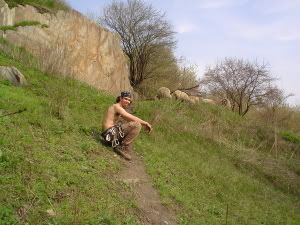
Me and sheep
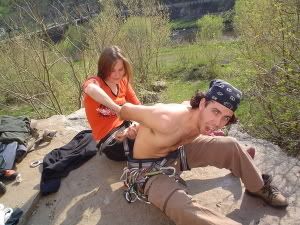
I'm not 100% sure how this match with Anya even started, but apparently I lost
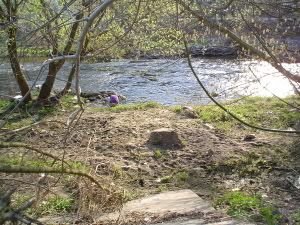
Marina washing her hands in the river after a day of climbing
Like every week for the past month, I’ve been visiting schools to show a video and pass out flyers for the climbing wall. I’ve discovered that there’s about a 1:10 ratio on flyers to show ups. I keep thinking that we’ll get overwhelmed on any given Saturday at the new trainings, but even if 40 kids say they’ll come, only 10 will show up. We average 8-10 new students each Saturday training, which is a good number considering the wall is fairly small. After a rotating roster of instructors, both friends, other Volunters and people from Polissya, my instructors have settled to three: Marina, Anya and Tanya. They are now veterans and at the last training I let them handle it from start to finish. I am becoming obsolete!
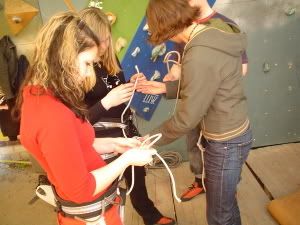
Marina teaching students
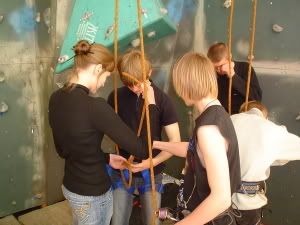
Anya teaching students
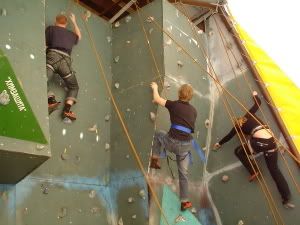
Students climbing
Why all girls? Um, because I'm working towards gender equality in the sport. And it's empowering to women. And, well, let's be honest, there can never be too many hot female climbers in the world. Eight months ago, none of these girls had ever climbed before and now they teach others to climb every week. Cool, huh?
If it makes anyone feel any better, I also have a special class after the Saturday trainings with five boys, they're just not as photogenic, as was proved when we all went to a club after climbing last Saturday:
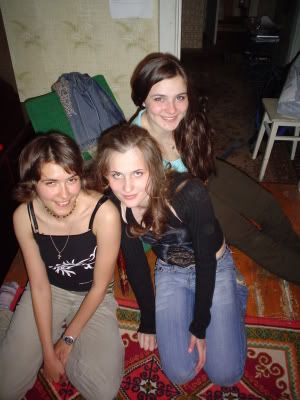
***
Found a new cliff in Zhytomyr last week. I’ve heard that there are five, but no one seems to know where they are. Lisa—-who was visiting for the weekend from Kharkiv--, Anya, Igor and I followed rumors that there was one along the Teatriv River and found it. It’s small, the flat remnants of granite quarrying, but in a beautiful location, back in the woods and just above the dam built across the Teatriv river, where water overflows it into a waterfall. The bolted routes are hard: between 5.10c and 5.11a, but we were able to anchor a rope to a tree so that Lisa and Igor could do some of the easier routes.
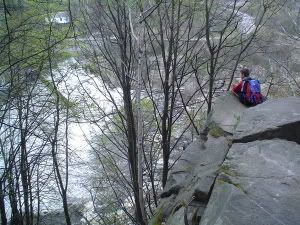
Igor on top of cliff, overlooking the waterfall
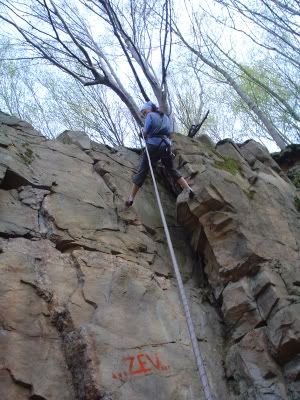
Lisa climbing
Getting back was an adventure. Rather than walk the mile back to the bridge we had used to cross the river, Igor suggested we cross on the rocks in front of the waterfall. He said he had done this before, but apparently that was in late summer when the water was lower. It was only when we were a quarter of the way out that we realized that too many rocks were underwater to make the crossing without getting our feet wet. Igor and I just plunged on, soaking tennis shoes and boots, respectively, but Anya and Lisa decided to take their shoes off.
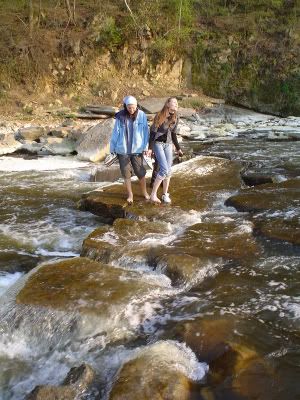
Lisa and Anya taking off their shoes
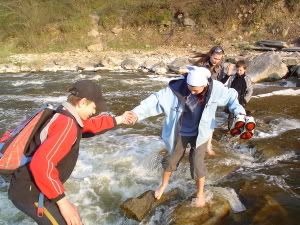
I'd like to point out that Igor is helping the girls while I'm off taking pictures. Quite the gentleman I am, huh?
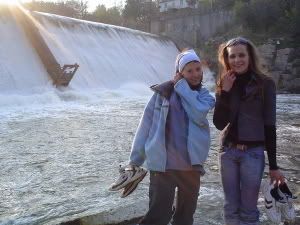
Lisa and Anya, halfway across
At one point Lisa dropped a shoe and I had to jump into the river, up to mid-calf, to retrieve it. I gave it back to her, tossed the backpack full of gear to Igor, several rocks away with fast moving water between us, and rather than wait, he put the pack on and started walking. I heard a yelp and turned around to see that Lisa had dropped her shoe into the water again and it was now beyond my reach, floating off down the river. I heard another yelp and turned back to see that Igor had fallen into the water halfway up his chest, completely soaking the backpack full of climbing gear.
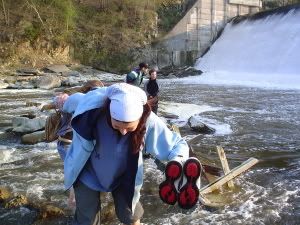
This is the last picture of Lisa with both shoes
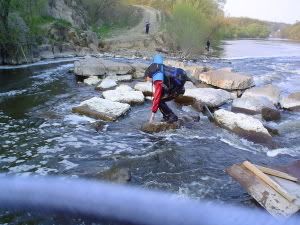
Igor, pulling himself and all the wet gear out of the water
People fishing on the banks were watching us like we were complete idiots, which, of course, we were. Lisa had the worst of it. By the end, she had also banged her shin and it was freely bleeding and had to walk back to my apartment in a pair of climbing shoes, getting blisters in the process. Still, she had brought two pairs of shoes with her from Kharkiv and thankfully didn’t have to buy a new pair to go home.
For her, it was an interesting introduction to Zhytomyr.
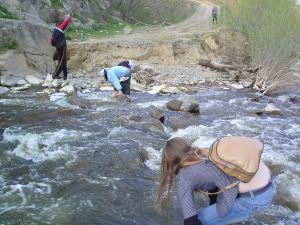
Almost to the other side.

People fishing and watching us
First, the weather has been absolutely beautiful lately, which is why I’ve been climbing whenever I have a free moment. Sheep also think the weather is beautiful, and have been grazing near the cliffs we climb.

Me and sheep

I'm not 100% sure how this match with Anya even started, but apparently I lost

Marina washing her hands in the river after a day of climbing
Like every week for the past month, I’ve been visiting schools to show a video and pass out flyers for the climbing wall. I’ve discovered that there’s about a 1:10 ratio on flyers to show ups. I keep thinking that we’ll get overwhelmed on any given Saturday at the new trainings, but even if 40 kids say they’ll come, only 10 will show up. We average 8-10 new students each Saturday training, which is a good number considering the wall is fairly small. After a rotating roster of instructors, both friends, other Volunters and people from Polissya, my instructors have settled to three: Marina, Anya and Tanya. They are now veterans and at the last training I let them handle it from start to finish. I am becoming obsolete!

Marina teaching students

Anya teaching students

Students climbing
Why all girls? Um, because I'm working towards gender equality in the sport. And it's empowering to women. And, well, let's be honest, there can never be too many hot female climbers in the world. Eight months ago, none of these girls had ever climbed before and now they teach others to climb every week. Cool, huh?
If it makes anyone feel any better, I also have a special class after the Saturday trainings with five boys, they're just not as photogenic, as was proved when we all went to a club after climbing last Saturday:

***
Found a new cliff in Zhytomyr last week. I’ve heard that there are five, but no one seems to know where they are. Lisa—-who was visiting for the weekend from Kharkiv--, Anya, Igor and I followed rumors that there was one along the Teatriv River and found it. It’s small, the flat remnants of granite quarrying, but in a beautiful location, back in the woods and just above the dam built across the Teatriv river, where water overflows it into a waterfall. The bolted routes are hard: between 5.10c and 5.11a, but we were able to anchor a rope to a tree so that Lisa and Igor could do some of the easier routes.

Igor on top of cliff, overlooking the waterfall

Lisa climbing
Getting back was an adventure. Rather than walk the mile back to the bridge we had used to cross the river, Igor suggested we cross on the rocks in front of the waterfall. He said he had done this before, but apparently that was in late summer when the water was lower. It was only when we were a quarter of the way out that we realized that too many rocks were underwater to make the crossing without getting our feet wet. Igor and I just plunged on, soaking tennis shoes and boots, respectively, but Anya and Lisa decided to take their shoes off.

Lisa and Anya taking off their shoes

I'd like to point out that Igor is helping the girls while I'm off taking pictures. Quite the gentleman I am, huh?

Lisa and Anya, halfway across
At one point Lisa dropped a shoe and I had to jump into the river, up to mid-calf, to retrieve it. I gave it back to her, tossed the backpack full of gear to Igor, several rocks away with fast moving water between us, and rather than wait, he put the pack on and started walking. I heard a yelp and turned around to see that Lisa had dropped her shoe into the water again and it was now beyond my reach, floating off down the river. I heard another yelp and turned back to see that Igor had fallen into the water halfway up his chest, completely soaking the backpack full of climbing gear.

This is the last picture of Lisa with both shoes

Igor, pulling himself and all the wet gear out of the water
People fishing on the banks were watching us like we were complete idiots, which, of course, we were. Lisa had the worst of it. By the end, she had also banged her shin and it was freely bleeding and had to walk back to my apartment in a pair of climbing shoes, getting blisters in the process. Still, she had brought two pairs of shoes with her from Kharkiv and thankfully didn’t have to buy a new pair to go home.
For her, it was an interesting introduction to Zhytomyr.

Almost to the other side.

People fishing and watching us
Wednesday, May 03, 2006
Ukraine: Climbing in Crimea
I had missed the clip. How had I missed the clip?
I was hanging at the top of a route, six feet above my last quick draw, left arm jammed past my elbow into a crack, left toe on a tiny nub of rock and nothing else stopping me from falling, falling, swinging, crashing.
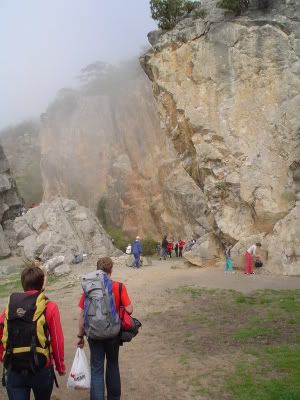
Coming upon the cliffs
I had been climbing for seven hours straight and had completed six routes, five of them on lead, all of them 5.10b's and 5.10c's. A 5.10 route, once considered the hardest climbs, are now only the bottom end of advanced climbing, but they're above the level of people who aren’t serious about the sport. Most of my early climbing was done in at a climbing gym in Oklahoma city, one built inside a huge grain silo. They didn’t use the numbering system for difficulty. Instead, easy was marked green, medium was marked blue and difficult was marked black.
I’d been on black all day.
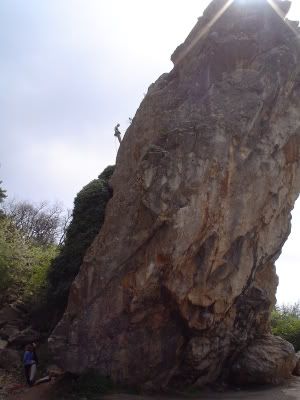
My friend, Dasha, working up to the top of a route called "Nuff-nuff"
A 5.10 route are the routes where you will be hanging by fingers, balanced on tiny toe holds or doing pull-ups and swinging a foot up to get past an overhang. They’re not 5.11s or 5.12s, where you do everything just mentioned but for the entire route, often at an acute backwards angle, but they’re still very difficult.
And, of course, there’s 5.13, which only the world’s best climbers can do, of which there was only one such route present at the cliffs in Crimea, a razor’s edge of featureless rock that required you to hang upside down by your fingers for most of it.
No one at the cliff went near it.
None of the people climbing around Jon and I were that good, but they were all damn good. Jon and I were puppies amongst the big dogs there, learning just how much we had to learn. We were, in two facing bluffs that stretched high before the Black Sea, in Ukraine’s rock climbing heaven.
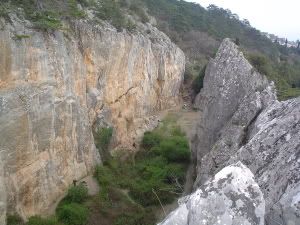
The cliffs
Jon still doesn’t trust his leading skills, which meant I had to lead almost all of the routes we did, wearing myself out in the process. Lead climbing is a giant evolutionary step from the top roping. When you top rope, the rope goes up from your harness to an anchor above you. Most people who have tried climbing have done top roping. If you fall on a top rope, you only fall a few inches. When you lead climb, though, the rope comes up from below and you clip it into bolts set into the rock as you go. Why lead climb? You have to: out on cliffs, no one is going to set a top rope for you. You have to lead up and set it yourself.
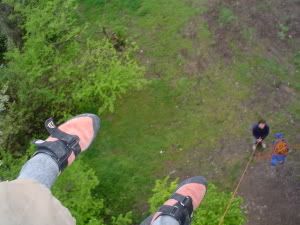
Sitting on top of a route called "Chimera". Jon is below
Lead climbing is more dangerous, though. If you are four feet above your clip, you will fall eight feet before you stop, swinging and slamming into the rock. The worst possible time to fall is right before you clip into your next bolt.
It can be a nerve wracking process: you reach a bolt and reach back and grab a quick draw-two carabineers attached by a short length of webbing--off your harness. You clip one carbineer into the anchor, then reach down to pull the rope to the other one. You are now at the worst part. You are holding on with one hand, feet precariously perched on whatever nub you can find, pulling up a rope which is being fed as fast as possible from below. Invariably you end up with slack, which means that if you miss clipping in and fall, you will fall that much farther.
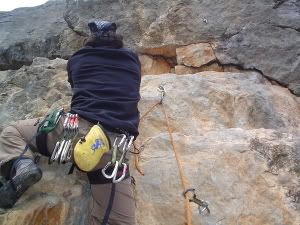
Here, you can see the basics of lead climbing: quick draws clipped into bolts and the rope. And you can also see my best side
The situation I was in was even worse: we were climbing on poorly formed limestone. Unlike the granite I’m used to, the rock had a surface like soap and my shoes could barely grip it. My hands were so tired from climbing all day that my fingers couldn’t stay clenched, which is why I shoved my arm into that crack. Now, if I fell, I’d be leaving a lot of skin behind.
I had thought I’d had strength left for one more route, a route called “Sim-Sim” as in “Sim, sim, Salabim!” what Aladdin yells to open the cavern. I jokingly said it before I started the route. The saying hadn’t helped: the route had started with a roof move, me hanging upside down and having to swing myself over an edge, grabbing a flake of rock with enough grip that I could pull myself over. That move took the last of my energy, but I was past the point of no return. The thing about lead climbing is that, if you don’t complete the route, you have to leave one of your quick draws on the wall so your partner can lower you down. Quick draws are only $18, but pride alone won’t let me leave gear on the wall. Besides, I only get paid $200 a month.
So I had to finish.
I kept working to the top of the route. If ever I found a crack big enough for my hand, I’d jam it in and rest for a bit. It wasn’t good for my hands, as my right one was already coated in chalk and blood.
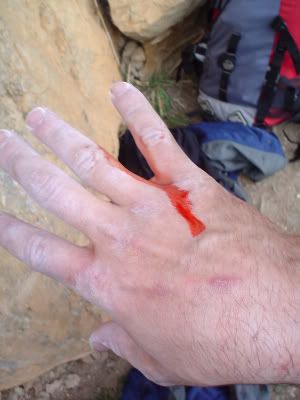
My poor hand,
Normally, climbing is just fun: feeling your body move in the warm sun up a rock face. Some days, like today, you just get in a push-yourself mood. Then it becomes the sport of masochists.
I did get up to the top, finally, to the top anchor which, luckily, was a drop-in: a big carabineer attached to the wall. Sometimes it’s just a ring, meaning you have to tie in with a piece of webbing, untie your rope, thread the rope through the ring, retie into the rope and then get lowered down. I didn’t really have the energy for that.
Lead climbing is taxing. It’s slower and you take more time between each move because you don’t want to fall. This means you spend a lot more time just gripping and looking at the wall for the best holds, time that tears up your muscles. And it’s mentally taxing. You’re focused every moment, planning, looking, feeling things through. Sometimes a minute can seem like an hour and an hour a minute.
The top anchor had a serious spring on it, which is why it didn’t move when I weakly pushed the rope at it and missed the clip, the rope falling out of my hand and down.
You learn a lot about yourself while climbing. One lesson is that you can always go farther than you think you can. My left side had started shaking. When you stand too long on a toe, your leg will start vibrating up and down. “Sewing machine leg”, they call it. Except now, my whole left side, arm jammed into the rock, toe on a nub, was trembling.
I only sort of dimly regarded it, though, because I simply knew one thing: falling would hurt a lot worse than the pain I was in now. At this point, it’d be a fall of fifteen feet, only slightly less than the height I fell from when I broke my leg. The rope would absorb some of the energy, but would swing me directly into the rock, a “face whipper” as climbers like to call it.
My hand came back up with the rope, smeared white and red. You learn things about yourself. Everyone has preprogrammed ideas of endurance that don’t give a real picture of how far your body can go, how much it can actually handle. Because as far as my conscious mind knew, I was out of energy, but my body, despite all the vibration, kept hanging on. Fuck it. I was not going to fall.
I shoved the rope through the clip and the gate swung back with a snap.
“Take!” I yelled, and Jon pulled all the slack out of the rope as I let go, forearm sliding out of the crack, feet leaving the rock and body dropping a few feet before just hanging.
I looked out. Fog had obscured the views the day before, but today, from the top of any given route, you could see over the trees, past the road, past the ramshackle houses and tiny farm plots on the hill side, and see the Black Sea.
Oh yeah, that’s why I do this.
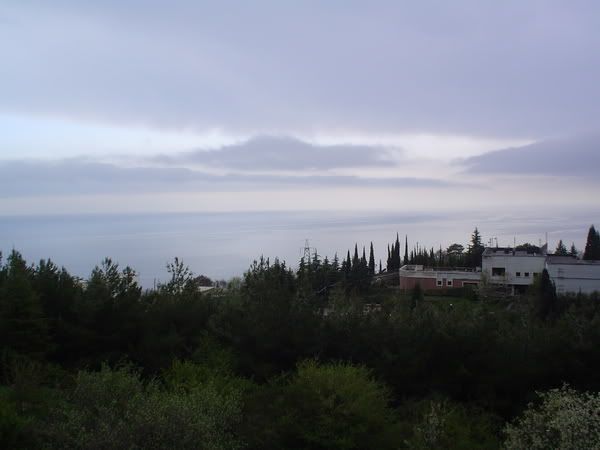
The Black Sea from the top of a route
My arms would hurt so bad the following night that the pain would keep me awake, but that was okay. I was a puppy running amongst the big dogs, and this is how I was going to get bigger.
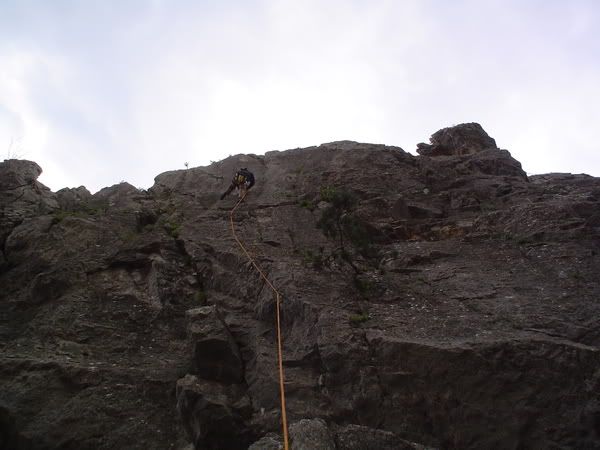
Me, climbing a route called "Kong"
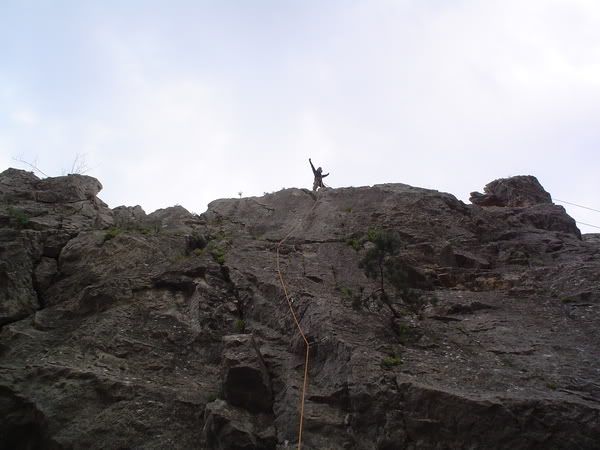
At the top
As I hung there, I thought about dinner and how good hot food would be. And we could watch Chappelle’s Show on Chandani’s laptop, and I could rest.
That’s what I thought about, along with a warm sense of accomplishment, as the adrenaline drained out and Jon lowered me to the ground.
I was hanging at the top of a route, six feet above my last quick draw, left arm jammed past my elbow into a crack, left toe on a tiny nub of rock and nothing else stopping me from falling, falling, swinging, crashing.

Coming upon the cliffs
I had been climbing for seven hours straight and had completed six routes, five of them on lead, all of them 5.10b's and 5.10c's. A 5.10 route, once considered the hardest climbs, are now only the bottom end of advanced climbing, but they're above the level of people who aren’t serious about the sport. Most of my early climbing was done in at a climbing gym in Oklahoma city, one built inside a huge grain silo. They didn’t use the numbering system for difficulty. Instead, easy was marked green, medium was marked blue and difficult was marked black.
I’d been on black all day.

My friend, Dasha, working up to the top of a route called "Nuff-nuff"
A 5.10 route are the routes where you will be hanging by fingers, balanced on tiny toe holds or doing pull-ups and swinging a foot up to get past an overhang. They’re not 5.11s or 5.12s, where you do everything just mentioned but for the entire route, often at an acute backwards angle, but they’re still very difficult.
And, of course, there’s 5.13, which only the world’s best climbers can do, of which there was only one such route present at the cliffs in Crimea, a razor’s edge of featureless rock that required you to hang upside down by your fingers for most of it.
No one at the cliff went near it.
None of the people climbing around Jon and I were that good, but they were all damn good. Jon and I were puppies amongst the big dogs there, learning just how much we had to learn. We were, in two facing bluffs that stretched high before the Black Sea, in Ukraine’s rock climbing heaven.

The cliffs
Jon still doesn’t trust his leading skills, which meant I had to lead almost all of the routes we did, wearing myself out in the process. Lead climbing is a giant evolutionary step from the top roping. When you top rope, the rope goes up from your harness to an anchor above you. Most people who have tried climbing have done top roping. If you fall on a top rope, you only fall a few inches. When you lead climb, though, the rope comes up from below and you clip it into bolts set into the rock as you go. Why lead climb? You have to: out on cliffs, no one is going to set a top rope for you. You have to lead up and set it yourself.

Sitting on top of a route called "Chimera". Jon is below
Lead climbing is more dangerous, though. If you are four feet above your clip, you will fall eight feet before you stop, swinging and slamming into the rock. The worst possible time to fall is right before you clip into your next bolt.
It can be a nerve wracking process: you reach a bolt and reach back and grab a quick draw-two carabineers attached by a short length of webbing--off your harness. You clip one carbineer into the anchor, then reach down to pull the rope to the other one. You are now at the worst part. You are holding on with one hand, feet precariously perched on whatever nub you can find, pulling up a rope which is being fed as fast as possible from below. Invariably you end up with slack, which means that if you miss clipping in and fall, you will fall that much farther.

Here, you can see the basics of lead climbing: quick draws clipped into bolts and the rope. And you can also see my best side
The situation I was in was even worse: we were climbing on poorly formed limestone. Unlike the granite I’m used to, the rock had a surface like soap and my shoes could barely grip it. My hands were so tired from climbing all day that my fingers couldn’t stay clenched, which is why I shoved my arm into that crack. Now, if I fell, I’d be leaving a lot of skin behind.
I had thought I’d had strength left for one more route, a route called “Sim-Sim” as in “Sim, sim, Salabim!” what Aladdin yells to open the cavern. I jokingly said it before I started the route. The saying hadn’t helped: the route had started with a roof move, me hanging upside down and having to swing myself over an edge, grabbing a flake of rock with enough grip that I could pull myself over. That move took the last of my energy, but I was past the point of no return. The thing about lead climbing is that, if you don’t complete the route, you have to leave one of your quick draws on the wall so your partner can lower you down. Quick draws are only $18, but pride alone won’t let me leave gear on the wall. Besides, I only get paid $200 a month.
So I had to finish.
I kept working to the top of the route. If ever I found a crack big enough for my hand, I’d jam it in and rest for a bit. It wasn’t good for my hands, as my right one was already coated in chalk and blood.

My poor hand,
Normally, climbing is just fun: feeling your body move in the warm sun up a rock face. Some days, like today, you just get in a push-yourself mood. Then it becomes the sport of masochists.
I did get up to the top, finally, to the top anchor which, luckily, was a drop-in: a big carabineer attached to the wall. Sometimes it’s just a ring, meaning you have to tie in with a piece of webbing, untie your rope, thread the rope through the ring, retie into the rope and then get lowered down. I didn’t really have the energy for that.
Lead climbing is taxing. It’s slower and you take more time between each move because you don’t want to fall. This means you spend a lot more time just gripping and looking at the wall for the best holds, time that tears up your muscles. And it’s mentally taxing. You’re focused every moment, planning, looking, feeling things through. Sometimes a minute can seem like an hour and an hour a minute.
The top anchor had a serious spring on it, which is why it didn’t move when I weakly pushed the rope at it and missed the clip, the rope falling out of my hand and down.
You learn a lot about yourself while climbing. One lesson is that you can always go farther than you think you can. My left side had started shaking. When you stand too long on a toe, your leg will start vibrating up and down. “Sewing machine leg”, they call it. Except now, my whole left side, arm jammed into the rock, toe on a nub, was trembling.
I only sort of dimly regarded it, though, because I simply knew one thing: falling would hurt a lot worse than the pain I was in now. At this point, it’d be a fall of fifteen feet, only slightly less than the height I fell from when I broke my leg. The rope would absorb some of the energy, but would swing me directly into the rock, a “face whipper” as climbers like to call it.
My hand came back up with the rope, smeared white and red. You learn things about yourself. Everyone has preprogrammed ideas of endurance that don’t give a real picture of how far your body can go, how much it can actually handle. Because as far as my conscious mind knew, I was out of energy, but my body, despite all the vibration, kept hanging on. Fuck it. I was not going to fall.
I shoved the rope through the clip and the gate swung back with a snap.
“Take!” I yelled, and Jon pulled all the slack out of the rope as I let go, forearm sliding out of the crack, feet leaving the rock and body dropping a few feet before just hanging.
I looked out. Fog had obscured the views the day before, but today, from the top of any given route, you could see over the trees, past the road, past the ramshackle houses and tiny farm plots on the hill side, and see the Black Sea.
Oh yeah, that’s why I do this.

The Black Sea from the top of a route
My arms would hurt so bad the following night that the pain would keep me awake, but that was okay. I was a puppy running amongst the big dogs, and this is how I was going to get bigger.

Me, climbing a route called "Kong"

At the top
As I hung there, I thought about dinner and how good hot food would be. And we could watch Chappelle’s Show on Chandani’s laptop, and I could rest.
That’s what I thought about, along with a warm sense of accomplishment, as the adrenaline drained out and Jon lowered me to the ground.
Subscribe to:
Comments (Atom)